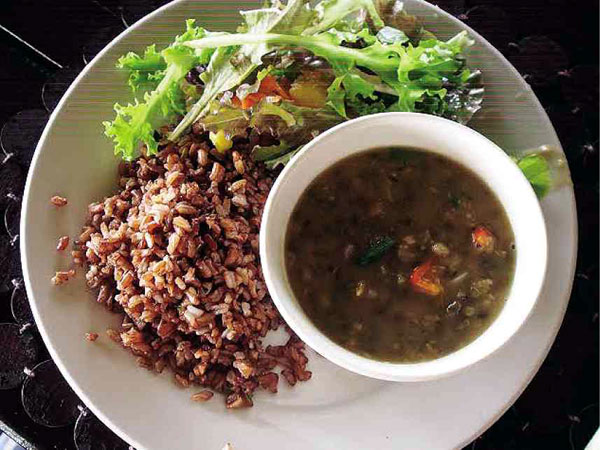
GREEN vegetables get a high 90+ mark in nutrient density; mung bean at 40; brown rice at 20. Lowest nutrient scores go to fish, dairy and meat.
If you plan to make just one health-related resolution this year, then make it a slim midsection, and be unrelenting in your mission.
Board-certified family physician and nutritional researcher Joel Fuhrman, author of “Eat To Live,” advised “the high volume of greens not only will be your secret to a thin waistline, but will simultaneously protect you against life-threatening illnesses.”
Certified nutrition specialist Rea Frey also gave helpful tips on how to remove “love handles.” Frey, who is also vegan and a certified trainer by the International Sports Sciences Association, is the author of “Power Vegan: Plant-Fueled Nutrition for Maximum Health and Fitness.” In her book, she said there are certain foods and exercises to target a slimmer middle.
Fuhrman, who specializes in preventing and reversing disease through nutritional and natural methods, wrote that green vegetables, fresh fruits, and legumes take the gold, silver and bronze medals in trimming waistlines. According to him, nothing else comes close insofar as diets are concerned.
Fuhrman’s “Eat To Live” book, available locally, includes recipes such as Spinach and Brussels Sprouts Marinara, Portobello-Red Pepper Pita, Simple Bean Burger, Thai Vegetable Curry, Vegetable Bean Burrito, Vegetable Omelet and No-Meat Balls. The book cites the nutrient-density scores of foods based on identified phytochemicals, antioxidant activity, and total vitamin and mineral content. The highest nutrient density score is 100.
Scores
A score of 100 goes to the dark, green leafy vegetables like kale, mustard greens, collard greens, Swiss chard, watercress, spinach and arugula. Other green vegetables like romaine, bok choy, cabbage, Brussels sprouts, asparagus, broccoli, string beans, snow peas and green peas get a score of 95.
Nongreen nutrient-rich vegetables like beets, eggplant, mushrooms, onions, radishes, bean sprouts, red and yellow bell peppers, radicchio, cauliflower, tomatoes, artichokes and raw carrots get 50, while fresh fruits like strawberries, blueberries, other berries, plums and oranges get 45.
Beans like lentils and kidney, get 40. Raw nuts and seeds are 30, colorful starchy vegetables such as sweet potatoes, corn, and turnips get 25; 20 for whole grains/white potatoes like old fashioned oats, barley, brown and wild rice, buckwheat, millet, quinoa, whole grain bread and white potatoes.
The lowest nutrient scores go to fish, dairy, eggs and meat.
Replaced
Frey replaced her family’s meat proteins with plant-based proteins like legumes and seeds and protein-rich grains.
“Using your entire core, when you move; eating enough of the ‘good’ fats, such as those in avocados, nuts, seeds, coconut, hemp, chia and flax; cutting down on processed, fatty foods; and ingesting plenty of fibrous, watery fruits and vegetables can get rid of love handles once and for all,” Frey said.
She recommends the following:
Eat: raw, unsalted, soaked nuts; seeds, quinoa; millet; buckwheat; cucumbers; berries; asparagus
Sweat: Plank Jack, Hip Escape, Burpee exercises
Live: Drink plenty of water to flush toxins from the body. Reduce stress by laughing and spending time with loved ones. Lighten up. Find humor and happiness in everyday situations, as stress can raise cortisol level, which often translates to belly fat. Depression can also lead to unwanted weight gain and lethargy. Reduce heavy restaurant dining (skip the bread basket and heavy extras, such as butter and creamy salad dressings).
Avoid: excess dairy, alcohol, processed meats, oils, butter
Frey’s “Power Vegan” book, available locally, also includes 42 vegan recipes such as Kale and Sweet Potato Hash, Kale and Garlic Chive Pesto Salad, Lentil-Quinoa Burger, Portobello Mushroom Burger, Red Bean Burger, Veggie Pizza, Zucchini Pasta with Tomato Sauce, Banana Walnut Chocolate Bread, and Raw Bean Salad.

